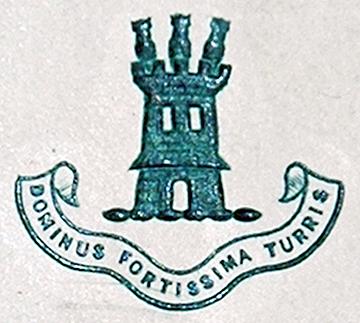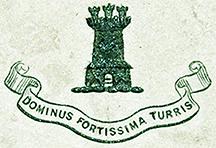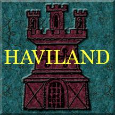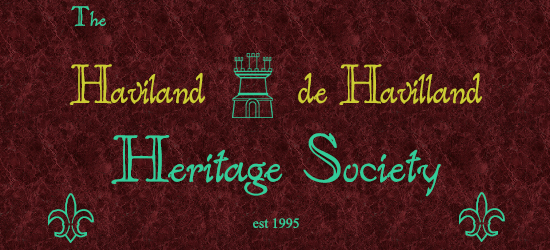The de Havilland Bearings
We begin our tale so far back in time that the College of Arms, established in 1484 by King Richard III, didn't even exist yet. But a note of caution: we are still working on the documentary evidences, and so the information provided here may be corrected or annotated as we learn more, and we are able to confirm or measure the accuracy of secondary information. A large amount of the below research was conducted by a group of individuals over a span of time including Thomas Fiott de Havilland (the builder of Havilland Hall on Guernsey) who wrote apparently the first book on the de Havilland genealogy, "A Chronicle of the Ancient and Noble Norman Family of de Havilland" in 1852, which was then updated and expanded by John Von Sonntag de Havilland (né Haviland) in 1865 (later to be published in 1895).
The earliest known form of the de Havilland Arms, being the family that settled on Guernsey, was very simple. It was a black castle with three towers on a silver shield:
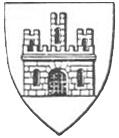
Blazon: argent, a Castle sable
Argent means "silver" (referring to the face of the escutcheon) and sable means "black" (referring to the castle on its face, which is categorically called a "charge"). These Arms were allegedly awarded to a descendant of the fief of Avilant (Abilant) on Neustria.
This particular charge (a castle with three towers) was most popularly used by the Castille royalty of Spain, but unrelated individuals could use the same charge so long as their Arms were distinct, such as a difference in tincture (coloring). The blazon for the simple Castille arms were, "gules, a Castle or," meaning a Red escutcheon with a gold castle.
We do not know to whom this Coat of Arms was originally awarded. A likely candidate was Robert, Baron of Avilant, in 1130. Later possibilities are Robert de Haverland, the Deputy Governor of Guernsey in 1179, and Phillipin de Havilland, who was one of the nobles present at the dedication of St. Martins' church in Guernsey in 1199.
Later, there was a one William D'Avilant, in the parishes of Golleville and St. Columba, near Valognes, Normandy, who allegedly accompanied King Richard Coeur-de-Lion (the Lion Heart) to Palestine. Not surprisingly, we have not found any corroborating evidence of this yet, but it would place him as a knight in 1191-1192, during the Third Crusade. The Chronicle reports that, in memory of this Crusade, two martlets (birds) were added to his paternal Arms. Like such:
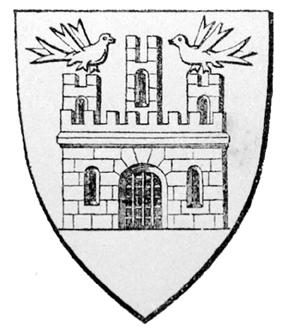
And so, William's son, Peter, whom may be his first born son, had a seal bearing Arms that also had martlets.
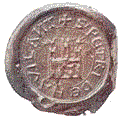
Peter, by a Charter dated the 1st of February 1260, ceded to the Monastery of Montisbourg (Normandy) his close dicto as Peissons in the parish of St. Martin of Golleville. (To this Charter is attached a green seal of his Arms, viz., a Castle triple-towered, and on each side-turret a Martlet, surrounded by--S’PETRI de HAVILANT. The seal, shown above, was found in the archives of St. Lo in Normandy in 1850.)
A seal was a signet that when pressed into hot wax would leave the impression of its bearing. Generally this would seal a scroll or envelope as an official endorsement and proof of its sender. The "S'" stood for sigillum (which means "seal.") Petri was a regional shorthand for Peter.
The Chronicle describes a similar seal, which we have reproduced herebelow:
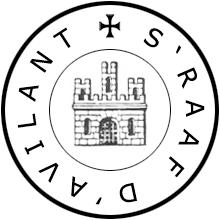
In point of fact, the Chronicle (under the pen of John V.S. de Havilland) actually records "S'RAAL D'AVILANT", but we suspect this to be an error. We believe it is more likely "S'RAAF D'AVILANT," as "Raaf" is shorthand for Ralf or, in its Romanized form, Radulphus. Such a character did exist. Radulphus D'Avilant was said to have been a jurymen on inquest, held regarding rights and customs of Guernsey, in the 23rd year of Henry III (ca 1239). He might be the same as Ralf de Haveilland who was a Jurat of Guernsey in 1254, and possibly the Bailiff of Guernsey in later years. He may have belonged to the paternal line that inherited the right to bear the original Arms.
You may have noticed this shape on both Peter's and Ralf's seals:
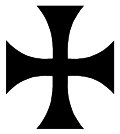
That is called a "cross pattée" or "cross formée." While it was commonly found on seals for many reasons, in the context of William and his descendants, it might symbolize participation in the Third Crusade.
The earliest ancestor that has been genealogically traced was Thomas, Sieur de Havilland, a Jurat of Guernsey in 1470. He had three sons: James, Thomas and Andrew. The story goes that Thomas's Arms were altered to have three castles rather than one like his ancestors, and that he passed this down to his eldest son, James.
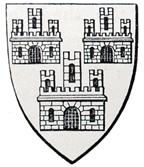
Arms of
James de Haveilland
(1440-1502)
Blazons: Argent three castles triple-towered sable
The story of the "three branches" sounds plausible, but the three-castled (and later three-towered) motif was common in medieval Heraldry. Here is the bearing of an early Castille:

Arms of
Le Roy de Chastell
Blazons: Gules three castles triple-towered or
At some point in history the imagery for the "castle" changed and began to look like a triple-towered tower. The use of "castle" vs "tower" became interchangeable, both as a charge and in the blazons.
"A castle is a fortress or stronghold, generally made of stone. It is an ancient charge, found in the canting arms of the King of Castile, c.1244. In early heraldry, no distinction was drawn between the
castle and the tower; late medieval heraldry, and Society heraldry, distinguishes between the two forms. The typical form is of two towers, joined by an embattled wall with a gate; a castle triple-towered has a third tower issuant from the joining wall."
--West Kingdom College of Heralds
There may have been a conscious effort by the de Havilland families, having moved to Guernsey and England and pledged to English sovereignty, to differentiate themselves from the Kingdom of Spain, which evolved from the Kingdom of Castille and bore the triple-towered castle as their charge. Matthew, the eldest son of Christopher Havilland (Bailiff of Poole in 1553 and Mayor of Poole in 1569, and grandson of Thomas of Guernsey), became Mayor of Bristol, Somersetshire in 1607. Occupying the Manor of Hawkesbury and being the landlord of Abbot's Grange, as well as owning property in Stockland-Bristol, Charlinch, and elsewhere, he was the wealthy progenitor of the Gloucestershire (Hawkesbury) family, now extinct, and of the Somersetshire family.
According to the Chronicle:
[Matthew] was a staunch supporter of the Protestant cause, and contributed largely towards the equipment of the fleet sent against the Spanish Armada.
-- The Chronicle de Havilland
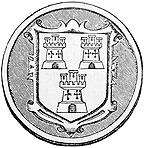
Seal of
Matthew Haviland
(1550 - 1619)
Blazons: Argent three towers triple-towered sable
The war with Spain was on the surface Protestants vs Catholics, but the deeper meaning behind it was the freedom of religion and the freedom of speech, which was central to the Protestant cause, and contrary to Catholic tradition.
.svg.png)
Arms of
Philip II
King of Spain & Portugal
It appears that Matthew's (4th?) son James continued the bearing of his father and added another tower as a crest to distinguish his line.
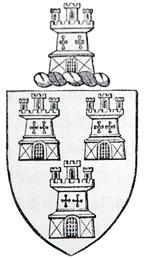
Arms of
John Haviland
(of Charlinch Hall)
(1579 - 1663)
Blazon of Arms: Argent three towers triple-towered sable.
Crest: On a torse, a tower triple-towered argent.
The tradition of Cadency in Heraldry is a way to distinguish the arms of younger brothers to the first born son who are also entitled to Arms. Since their bearings must be differenced, Cadency systemizes a way to identify second born son, third born son, etc. According to these rules, the second born son will therefore have a crescent on the escutcheon. And so, John, the second son of John of Charlinch Hall, looked thus:
-sm.jpg)
Arms of
John Haviland
(the Younger of Charlinch Hall)
Blazon of Arms: Argent three towers triple-towered sable, a crescent for difference.
Crest: On a torse, a tower triple-towered argent.
John (the Younger) had appeared and entered his pedigree at the Visitation of Somersetshire in 1672, according to the Chronicle. (A Heraldic Visitation is an event wherein the pedigree (the ancestry) of a noble is inspected to ascertain the right to bear Arms, and his Arms granted or registered.) John's first son was Dr. John Haviland, M.D., of Hart Hall, who was appointed to take charge of the Royal Naval and Military Hospitals at Plymouth. He very likely inherited the Arms of his father.
He also had a son named John, of Exeter College, Oxford, who was Vicar of South Petherwyn and Trewin in Cornwall. He died unmarried in 1762 with Arms that replaced the triple-towered tower with a "helm" (a helmet) for a crest:
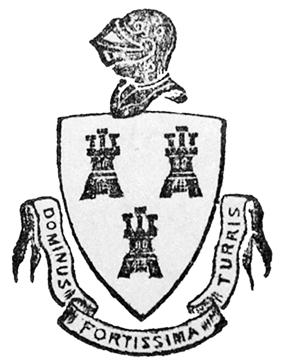
Arms of
Rev. John Haviland
(ca 1700 - 1762)
Rev. John Haviland's step-brother was Captain Peter Haviland (1690 - 1775) of the Royal Navy, who had a son General William Haviland (1718 - 1784) about whom much is written. General Haviland served under General Amherst in the Capitulation of Montréal in 1760, led brigades in the Invasion of Martinique in 1762, and passed away as a Full General in Great Britain in 1784. His son, Thomas Haviland of Penn, attained the rank of Lt. Colonel and died upon the same year as the birth of his only child, Thomas William Aston Haviland.
Royal License to Thomas William Aston Haviland to take the name of Burke in addition to that of Haviland, and quarter the Arms of Burke with those of Haviland, as the sole Representative in blood of the Right Honourable Edmund Burke.
-- Chronicle de Havilland, p. 112
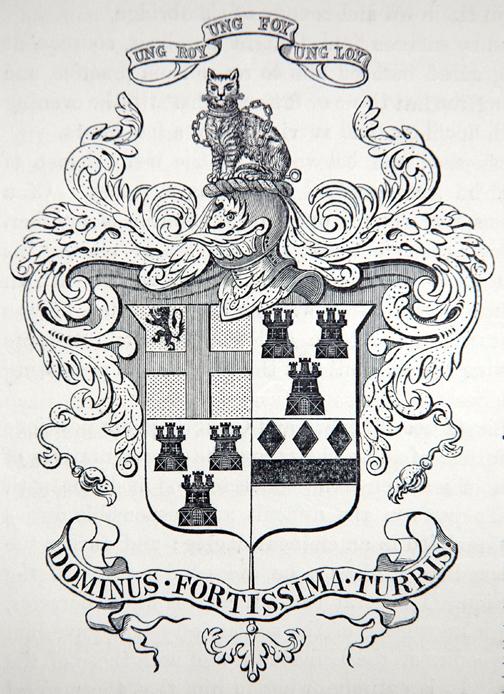
Arms of
Thomas William Aston Haviland-Burke
(1795 - 1852)
Burke (Haviland Burke, exemplified 1818 to Thomas William Aston Haviland, Esq., grandnephew and heir of the Rt. Hon. Edmund Burke, on his taking the surname and arms of Burke). Quarterly, 1st and 4th, Burke, or, a cross gu. in the dexter canton a dexter hand couped at the wrist sa.; 2nd and 3rd, Haviland, ar. three castles triple-towered sa. portcullised gu. Crest--For Burke only: A cat sejant ppr. collared and chain reflexed over the back or. Motto--Vinctus sed nòn victus.
-- The General Armory of England, Scotland, Ireland, and Wales, p. 147
"In a sketch printed in the New York Herald, March 9, 1905, the Haviland arms were described as follows, viz: Videlicet, or, a Cross Gules, in the dexter Canton a Lion rampant Sable. Second and Third, Argent three Towers triple towered Sable. Crest, In a Wreath of the Colours, A Cat sejant Proper collared, and chain reflexed over the back Or."
It is surprising that a writer on genealogical or heraldic subjects should have made such an absurd blunder as the above. These were the arms used by Thomas William Aston Haviland, who added the surname of Burke in addition to Haviland, being the sole representative in blood of his maternal grandmother, Julia Burke, sister of Edmund Burke, and also bore the arms of Burke quartered, with those of Haviland, both by royal license."
--Josephine C. Frost, The Frost Genealogy, 1912
Other descendants of John Haviland (the Elder of Charlinch) also used a helm for the crest, and mounted the triple-towered castle on top of it. Matthew of Wellisford House in Langford-Budville was another son of John (the Elder of Charlinch); Matthew's son was John of Gundenham Manor (Somersetshire); John's son was Edward of Peyton or Langford; his son was Dr. John Haviland, Esq. of Gundenham Manor who had two sons:
1) John, Esq. of Gundenham Manor
2) James, Esq.
In regards to (1) John of Gundenham, with the daughter of Rev. Samuel Codrington Glover, the Vicar of St. Mary's in Bridgewater, he had one son: Dr. John Haviland, M.D. of Gundenham (1785 - 1851), whose Blazons are as follows:
John Haviland, Esq., M.D., of Gundenham and Ditton Hall, Lord of that manor, co. Cambridge, regius professor of physics, professor of anatomy, and fellow of St. John's Coll. Cambridge, b. 2 Feb. 1785; m. 31 March, 1819, Louisa, youngest dau. and co-heir of the Rev. George Pollen, of Little Bookham Manor House, co. Surrey, and by her left issue at his decease, 8 Jan. 1851… Arms — Argent, three towers triple towered, sable, quartering Glover and Pollen. Crest — Out of a ducal coronet, sable, a tower, triple-towered, argent, portcullised, gules. Motto — Dominus fortissima turris. Estates — In the counties of Somerset and Cambridge. Residence: Faldbury Rectory, near Pershore, Worcestershire.
Burke's Genealogical and Heraldic History of the Landed Gentry, Vol 1, p. 601
We do not have an image to represent that Achievement.
In regards to (2), James, son of John, the Chronicle reports that he survived being a prisoner of war in Brest, France during the French Revolution and recounts an exciting act of self defense, unarmed but with a hot fire poker against a man bearing a sword. He had three sons:
1) Dr. James Haviland (1788 - 1869), Surgeon and Mayor of Bridgewater (1848 - 1849), whose son Dr. Alfred Joseph Haviland, the first Medical Officer of Health for the Northamptonshire Districts in 1873, a pioneer of medical mapping and a renowned opponent of Reverend Edward Thring in a scandal involving the death of students from a typhoid outbreak for which Thring blamed the town and Haviland blamed Thring. Alfred was a contributor to the Haviland genealogical writings, having corresponded with researcher Frederick Haviland and others. Alfred's son Charles Cobleigh Haviland inherited an original copy of John V.S. de Havilland's version of the Chronicle de Haviland published posthumously in 1895, which is now in the personal property of Christopher Sirmons Haviland.
2) John Haviland, Esq of Gundenham Manor, Somersetshire, who, at the bequest of Admiral and General Sir George von Sonntag, immigrated to the United States of America with testimonials written on his behalf to then President James Monroe, and settled in Philadelphia. There, he established himself as an architect of high station, with one of his most well known works being upgrades to the Toombs prison of New York. An image of his Arms are herebelow.
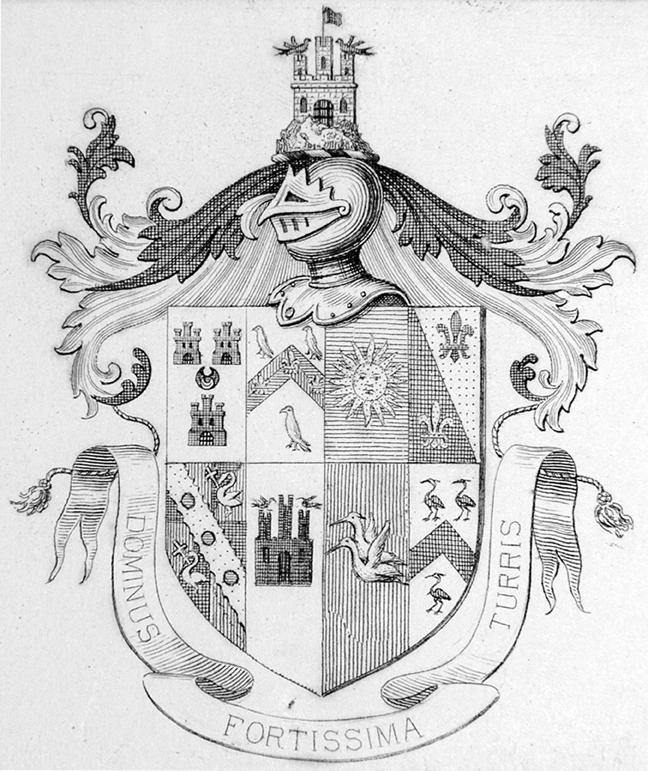
Arms of
John Haviland of Gundenham Manor
(1792 - 1852)
Architect, Philadelphia, United States of America
Blazon of Arms:
Argent, three towers, triple towered, sable, portcullised, gules; quartering Cobley, gyronny of eight, gules and sable, on a bend, engrailed, or, between two swans with each a cross-crosslet fitchée in its beak, argent, three hursts.
Crest:
Out of a coronet, sable, a tower, triple towered, argent, portcullised, gules
-- Burke's Genealogical and Heraldic History of the Landed Gentry, Vol. 1, p. 601
Note that the blazons for John the Architect as depicted in Burke's Landed Gentry do not reference the crescent (a mark of Cadency for Haviland, possibly as the second son of James), nor does it mention the martlets which conspicuously appear on two of the triple-towered castles. In regards to the castles, also note that the image shows two forms of art for the "castle" - that of the "tower" (which the blazons refers to as castles) and that of the older Castille-like castle, and that the two "castles" have martlets (the birds perched on their towers, akin to that of William the Crusader, aforementioned). As John is descended from the ancient de Havillands through multiple lines, it is possible that the duplication of castles can be that way explained. The coronet (a "crown") upon the helm is also illustrated in an odd way by this artist.
John Haviland's son, John, changed his name back to the form "de Havilland" and in 1865 would rewrite and expand Thomas Fiott de Havilland's Chronicle de Haviland (of 1852) into the form that thankfully was published posthumously in 1895 and has survived. His full name becoming John von Sonntag de Havilland, he was more than enthusiastic about the family genealogy and heraldry, and was a character of some notoriety. When he became a Professed Knight in the Order of Malta in 1870, his Arms were altered with the Star of the Order of St John of Jerusalem:
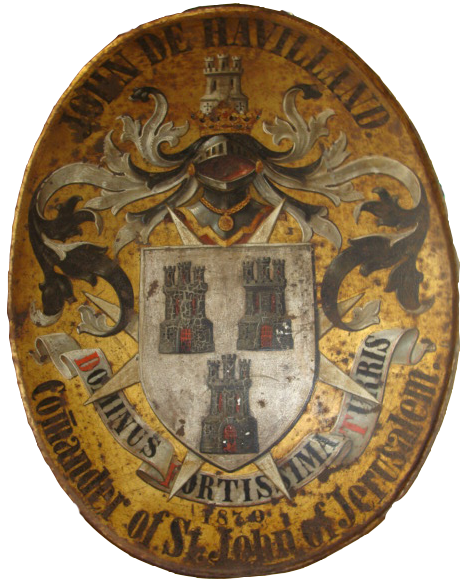
A Shield bearing the Malta Arms of
John von Sonntag de Havilland
(1819 - 1886)
Upon his becoming a Professed Knight of Justice of the Order of Malta in 1870
John was one of only two men born in the United States of America to have become a Herald in the College of Arms in 1872.
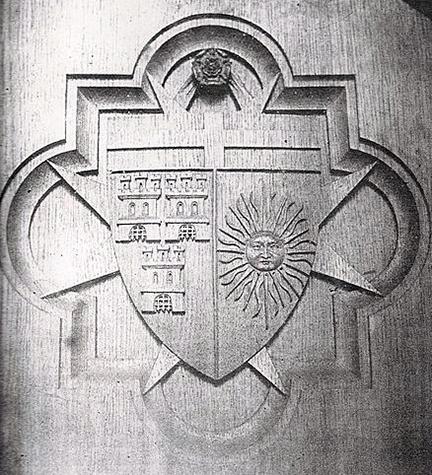
Modified Arms of
John von Sonntag de Havilland
(1819 - 1886)
Upon his advancement in 1872 to York Herald of Arms in Ordinary
in the College of Arms
(now quartered with the arms of his mother's father,
Captain W. L. von Sonntag of the French Army)
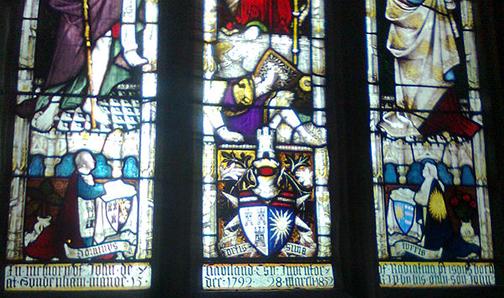
Stained Glass Windows showing the Modified Arms of
John von Sonntag de Havilland
(1819 - 1886)
At St Peter's Church at Langford Budville, Somerset, England
Let's return momentarily back to James de Haveilland (1440 - 1502). His son John de Havellande (1526 - 1607) was Mayor of Poole in 1514, 1520, 1526 and 1534, and purchased the Manor of Wilkeswood in the Isle of Purbeck ca 1530. He also had a son named John, born 1526 on the Isle of Purbeck, (although there is a discrepancy of sources that this John is the son of William the son of James, rather than the son of John the son of James. The Chronicle places him as the son of John the son of John the son of James.)
John's son Anthony Havelland has arms as shown below, marshaled with the Arms of his mother's father, Thomas Carew of Higherham Manor in Dorset.
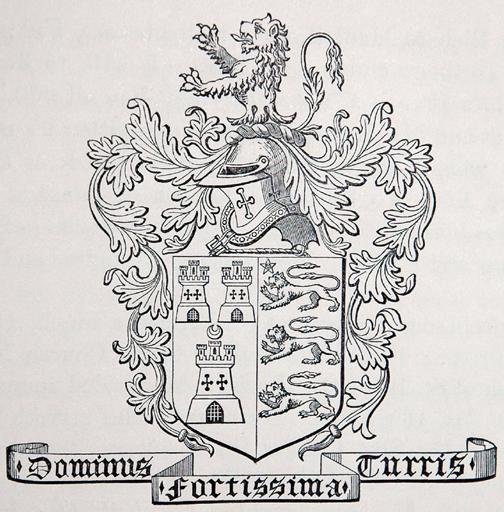
Arms of
Anthony Havelland
The brother of John Haviland, the Architect, was Thomas Haviland, who emigrated to Boston as a boy and became a plasterer. His son, Thomas Philip Haviland (1796 - 1873) served in the Civil War in the 12th Massachusetts Regiment as a 1st Lieutenant under Colonel Fletcher Webster (son of the famous statement, Daniel Webster). A family story tells that when Colonel Webster was mortally wounded at the second battle of Bull Run in 1862, Philip cradled him in his arms instead of fleeing, and as a consequence Thomas Philip was captured by the Confederate forces and had to endure the infamous Libby prison, writing on pages of the Bible to keep a diary. He was later promoted to Major.
A son of Major Philip Thomas was Arthur Haviland (1856 - 1917), who worked for the Susquehanna Coal Company providing coal for the Pennsylvania Railroad. He named his son after his father: Thomas Philip Haviland (1897 - 1969), a professor of American Literature at the University of Pennsylvania specializing in John Milton, Poe, Faulkner, Frost, Robinson, Jewitt, and his friend Jerry Brace, and also taught creative writing.
Dr. Thomas Haviland's son, Dr. William Arthur Haviland, is a Professor Emeritus of Anthropology at the University of Vermont, where he has taught since 1965. He has written many text books on Anthropology, and has shared his Coat of Arms with us hereunder:

Arms of
Dr. William Arthur Haviland
Professor of Anthopology
The artist for this Achievement interpreted the triple-towered towers differently, stacking the triple towers rather than standing them perpendicularly.
Other descendants of Thomas, Sieur de Haveilland stayed on Guernsey and retained the surname "de Havilland."
The bookplate for Peter de Havilland (1747 - 1821), an 8th great grandson of Thomas, son of John de Havilland & Mary Dobrée, reveals what might be his partial Coat of Arms (probably not the full Achievement):
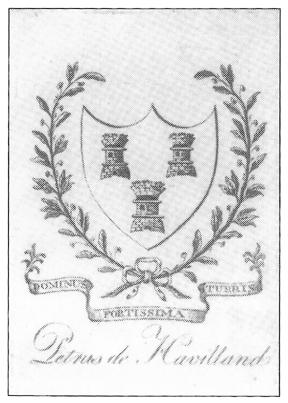
Bookplate of
Peter de Havilland
(1747 - 1821)
Bailiff of Guernsey
Peter was an Advocate of the Royal Court in 1770, a Jurat in 1785, and Bailiff (the highest position in Guernsey government) in 1810. He was the 2nd great grandfather of actresses Olivia de Havilland & Joan Fontaine (née de Havilland), and of Sir Geoffrey de Havilland, founder of De Havilland Aircraft.
One of his sons, Lt. Colonel Thomas Fiott de Havilland, who build the mansion still called Havilland Hall in St. Andrew's Parish on Guernsey in 1813, was highly interested in genealogy and wrote the first book about the family: the original Chronicle de Havilland. No known copy of this volume is known to have survived, but the rewrite of the Chronicle by John. V.S. de Havilland would ultimately preserve his work.
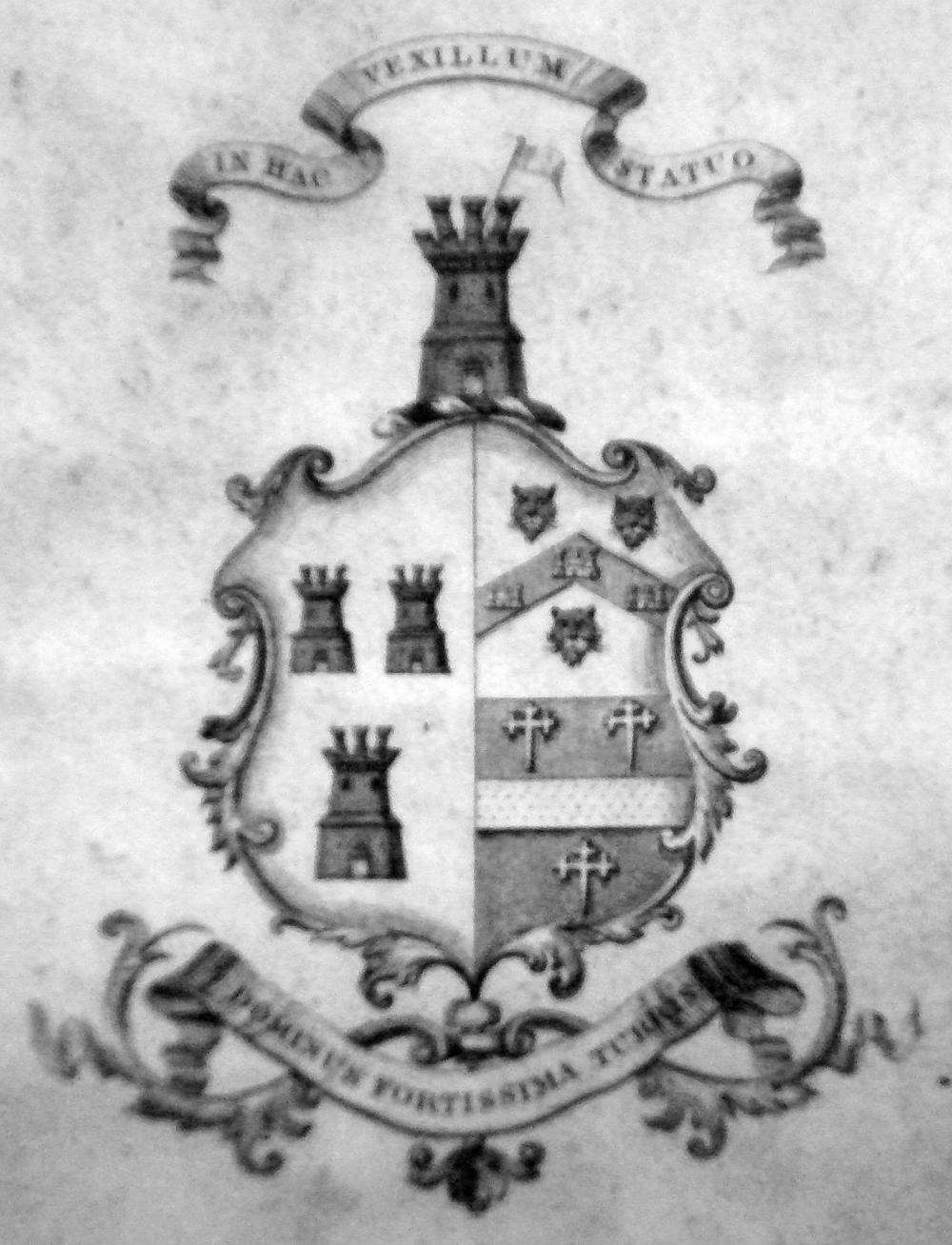
Arms of
Thomas Fiott de Havilland
( 1775 - 1866)
The brother of Thomas Fiott de Havilland, Charles de Havilland (1786 - 1844), was a Brevet-Major, having served in the Maltese Corps and the 8th Regiment of Foot, and was at one time prisoner of Napoleon in France, from whence a letter written to his father Peter, the Bailiff, was eventually passed down to Sir Geoffrey de Havilland (the aircraft inventor) who mentioned it in his autobiography.
Charles had a son James de Havilland (1828 - 1906), a Major General in the army, and evidence of his bookplate has also been discovered, which is identical to his grandfather's:
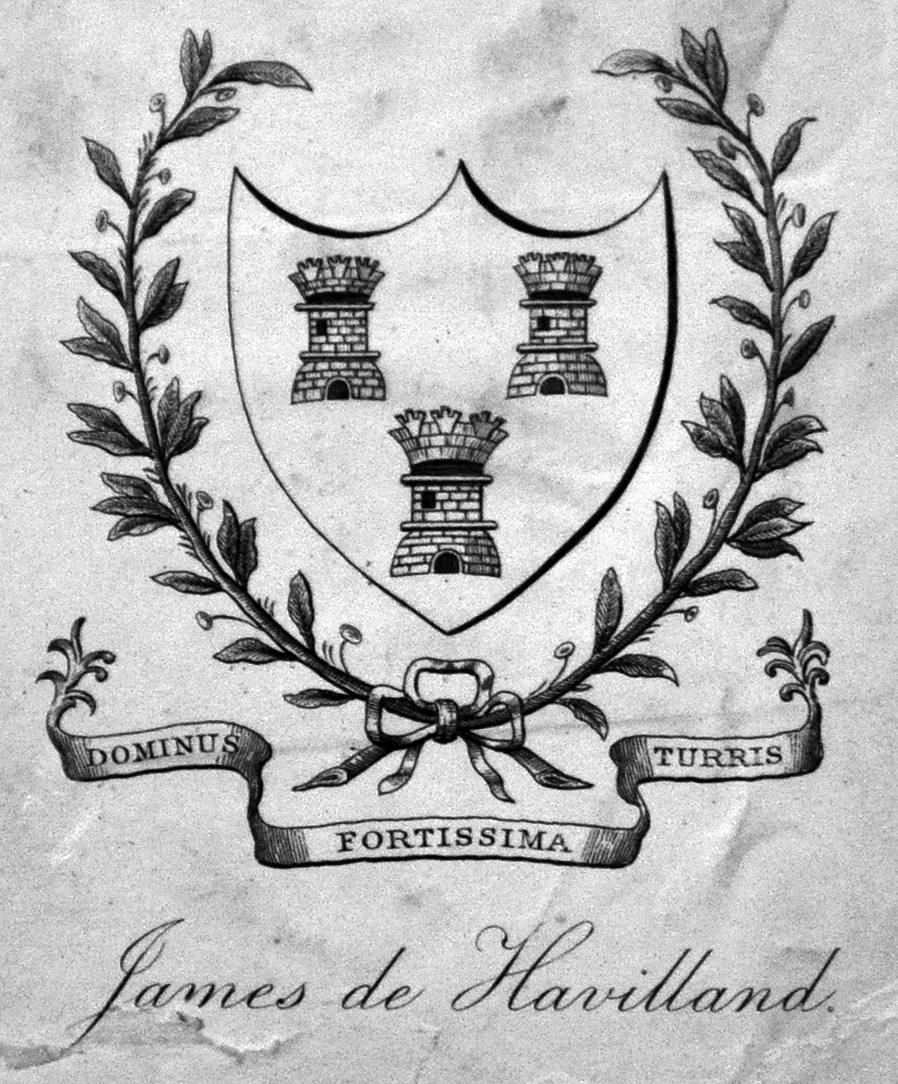
Bookplate of
Major General James de Havilland
(1828 - 1906)
[from a copy of the book Rome by Francis Wey]
Traces of Bearings in America
William Haviland (1606 - 1697) is presumed to be the son of James Haviland (1553 - 1613, Mayor of Salisbury) the son of Christopher (1519 - 1589, Mayor of Poole). This has been contested. James is himself listed in the pedigrees published with the Visitations of Gloucestershire and Somersetshire for the granting of Arms to Robert Haviland of Hawkesbury, the blazons of which reads, "Argent, three towers triple-towered sable," etc.
The Passenger and Immigration Lists Index, 1500s-1900s shows William Haviland arriving in Rhode Island in 1639. He was recorded as a Church Warden in Newport in 1646, and as a freeman of Newport in 1653 along with future governor of that place, Benedict Arnold. He and Benedict would own land in close proximity until William relocated to Great Neck, Long Island, New York, where in 1685 he co-signed a renewal charter of the Patent of Flushing. A majority of the Havilands in America and Canada can be traced genealogically back to William, and where the genealogy is hard to prove, it has been validated with Y-DNA evidence.
While we have not yet proved exactly the father of William, we know for certain he came from the armigerous family of de Havilland (hailing originally from Guernsey). Artifacts bearing William's Achievement were passed down as heirlooms until they eventually disappeared. His grandson, John Haviland (ca 1689 - 1747, son of Benjamin Haviland and Abigail Mott) had some:
[John] had an old fashioned tall clock with coat of arms, also his watch, with seal and coat of arms, which he willed to his eldest son, but the clock was stolen by marauders during the Revolutionary War and the watch with seal and coat of arms cannot be found.
-- The Haviland Genealogy, by Josephine C. Frost (1914)
The Will of John's brother, Ebenezer Haviland (1702 - 1749, son of Benjamin Haviland and Abigail Mott), dated 7 Dec 1749, proved in New York, 1 Jan 1749, states that his "watch and seal with coat of arms" be left to his son Ebenezer when he comes to the age of 21 years.
And then Ebenezer's son, Ebenezer Haviland (1742 - 1806), wrote in his own Will, “First, I give unto my nephew Anthony B. Haviland my silver watch and coat-of-arms..."
Next, Anthony B. Haviland (1783 - 1836, son of Thomas Haviland & Helena Bartow, Thomas being the brother of Ebenezer) died without issue at 53 years of age. The artifacts with the Coat of Arms was nowhere to be found thereafter. Josephine Frost believed they might have been lost in a fire in Brooklyn ca 1850 when Anthony's sister Charity’s house burned to the ground.
Mrs. Esther Gedney (née Haviland, 1768 - 1859, daughter of Joseph, son of Jacob, son of William Haviland) said, according to Frost, that she knew there was a Coat-of-Arms in the family. She was living in 1804 in Harrison, NY.
A letter written by Frederick Haviland (1847 - 1902, importer of the family's China and a genealogy enthusiast) to David Akin Haviland (1818 - 1899, of Fort Dodge, IA, son of Isaac, son of Isaac, son of Issac, son of Benjamin Haviland and Charity Farrington), dated September, 1894, states:
I had the pleasure of spending last Sunday in Pawling in company with your son, Francis P., and his wife and Mrs. Eletha Allen. From them I obtained much information about your branch of the family. I had previously called on Mr. Archibald Dodge who also gave me all the information he could. Your son tells me that you have an old heirloom in your family which is a copper or brass bed warmer with a long handle which has on it an inscription similar to the family coat of arms, three towers, illustrations of which I enclose. He thought the top part varied a little. Will you please compare it with the several sheets I send you and then write and tell me which one, giving the number, comes nearest to it, also describe as near as you can the top part or crest which varies from mine. Please let me know the history of the bed warmer as far back as you know it. When did it come into your possession and how many of your ancestors had it? Did you ever know or hear of anything else in the possession of your family being marked with the same kind of inscription or Coat-of-Arms?”
No reply to this letter has survived, to our knowledge.
In a letter written by John W. Haviland (1804 - 1861, son of Thomas, son of James, son of Thomas, son of Benjamin Haviland and Abigail Mott), probably in response to an inquiry by Frederick Haviland (1847 - 1902), he writes:
I think Dr. Haviland must be one connected with the coat of arms you spoke of. I find my father has a great idea of the splendour and aristocracy of the Doctor’s family. The Doctor he thinks, entered the army as surgeon and died while in the army. Aunt Tamar he says, lived many years after the Doctor’s death.
Of course the Dr. Haviland he is referring to is Ebenezer (1742 - 1788, son of Thomas, son of Benjamin Haviland and Abigail Mott), owner of the Haviland Inn in Rye, NY (known by George Washington and John Adams; and which now belongs to the Rye Historical Society). However we haven't found any record or trace of the Haviland Coat-of-Arms in that family either, and have wondered if one of his descendants has any knowledge of this, as the Haviland Inn and the family of Dr. Ebenezer Haviland is well researched.
Conclusion
It is no surprise that Heraldic bearings were not maintained in America, especially after the Revolutionary War. While a few Havilands were Tories (loyalists to the King of England), William himself may have taken his leave of England's politics of the time, leveraging the naval enterprises of his uncle, Matthew, to find a new life. This may not have been popular with his immediate family, as there are very few records of him in England. Aside from printings of his bearing on personal property, he did not care to maintain or formally pass down Arms. He and his sons and grandsons contented themselves as farmers in the colonization of the "New World," fiercely Protestant and independent in spirit. Some of the family he left behind might have been Catholic, and the Reformation caused branches of some families to become "disowned." Details of any of this, if it happened to the Havilands, are lost in time.
For an American man to obtain a true Coat of Arms he must prove himself descended from an English subject (preferably armorial) and then commission the College of Arms in the United Kingdom to have one made based on known family history.
Many have purchased a so-called "Family Coats of Arms" online, but unfortunately this is an information scam. The images that appear online associated with your surname are either fictional or they are Coats of Arms that had been awarded to specific Armigerous Bearers of England, Scotland, etc who had a surname that appears to be the same as yours.
And so you may not even be related to the person to whom that Achievement belongs, let alone have a paternal descent from them, from eldest son to eldest son. There are many unrelated surnames of the same spelling. The Havilands, in fact, have fewer than most surnames. Our Y-DNA study has identified just a handful of separate genealogies with the Haviland surname, and a few might be unrelated due to adoption somewhere along their line. But a vast majority of Havilands and de Havillands are descended from the armorial family of de Havilland from Guernsey.
Coats of Arms don't represent surnames.
Therefore, do not buy Coats of Arms online and declare it to belong to you or your family. Displaying someone else's Coat of Arms does not express "pride" in the family surname, as such merchants want you to believe. They just want your money.
Please read my article What is Our Family Coat of Arms? which includes information about how to get a real one.
--Christopher Sirmons Haviland
President, The Haviland Heritage Society
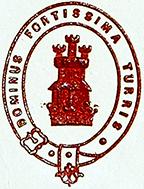
A Haviland Ink-Stamp Impression
